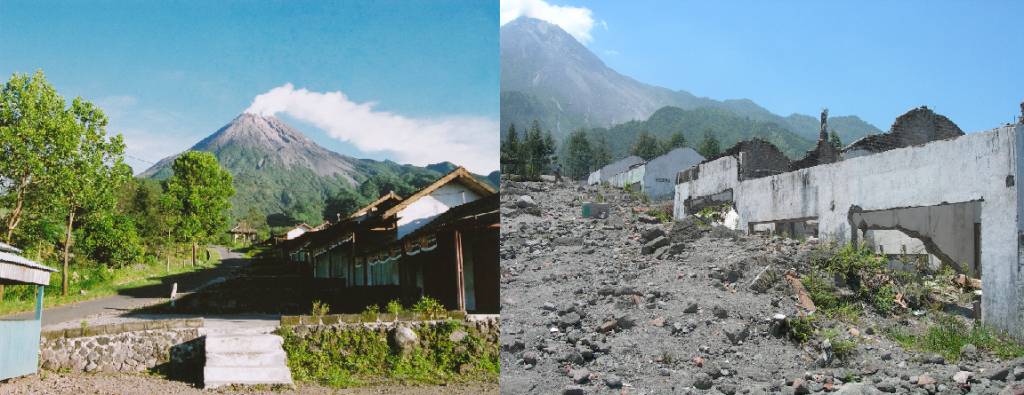8 December 2011
Scientists simulate explosive volcanic eruptions in the lab
Posted by kramsayer

: The Indonesian village of Kali Adem at the base of the Merapi volcano in Central Java, before (left) and after (right) the 2006 eruption. (Credit: Valentin Troll and Frances Deegan)
Recipe for a volcano: take some rock powder from a recent eruption (basaltic-andesite works best), combine with some limestone in a small capsule, and cook in a pressure-cooker at 1200 degrees Celsius (2200 Fahrenheit) until gas bubbles form. Serve warm.
For the first time, researchers at Uppsala University in Sweden have recreated in a lab the step-by-step chemical reactions occurring in explosive volcanoes. The team studied one of the planet’s most active and dangerous sites, Indonesia’s Merapi volcano. Merapi’s dome expands during long intervals of quiet, which are punctuated every several years by violent, explosive eruptions. These explosions spew out crystal-rich basaltic-andesite, which contains rock fragments encased in shells of hardened magma, called inclusions. These layered chunks of rock are abundant on Merapi – researchers find them just lying on the ground near the volcano.
The Swedish scientists were intrigued by one type of inclusion called “Calc-silicates,” formed when magma engulfs bits of limestone from the earth’s crust, eating away at the calcium carbonate limestone and causing it to expand, crack and melt.
“It pointed to the fact that magma and crust were somehow interacting and liberating gas,” said Frances Deegan, a member of the Uppsala team. That was the first clue that magma was disintegrating parts of the Earth’s crust in these eruptions.
The Swedish team was led by petrologist Valentin Troll who presented a poster on the research Tuesday morning at the American Geophysical Union’s Fall Meeting. Following the recipe described above in their lab, the team took powdered, dried magma from Merapi and combined it with limestone in a small capsule half the size of a pencil eraser. They placed the capsule inside a superheated, super-pressurized piston about the size of a refrigerator.
Inside this simulated volcano, bubbles of carbon dioxide form from the limestone, as the carbonate starts to break down and mix with the molten rock – magma – surrounding it. The magma can’t hold that much CO2, so bigger bubbles form, ready to burst out. It’s these escaping gas bubbles that make volcanoes like Merapi erupt so explosively.
“We are doing something very new,” Troll said: “Recreating the individual steps of the process we see in nature.” Troll compared the reaction to a school chemistry experiment, where you combine hydrochloric acid with a base and it starts to fizz. The volcano scenario is similar, where magma is the acid and limestone is the base, only the fizzing is much more dramatic.
Earthquakes might actually exacerbate eruptions, by shaking up the limestone-and-magma mix, making the reaction even more volatile. The large 2006 earthquake in Indonesia intensified the eruption of Merapi that year by a factor of five, Troll said. Improving our understanding of ticking infernos like Merapi, he said, could be critical for escaping the destruction they wreak on some of the world’s most densely populated areas.
-Tanya Lewis is a science communication graduate student at UC Santa Cruz.


 GeoSpace is a blog on Earth and space science, managed by AGU’s Public Information staff. The blog features posts by AGU writers and guest contributors on all sorts of relevant science topics, but with a focus on new research and geo and space sciences-related stories that are currently in the news.
GeoSpace is a blog on Earth and space science, managed by AGU’s Public Information staff. The blog features posts by AGU writers and guest contributors on all sorts of relevant science topics, but with a focus on new research and geo and space sciences-related stories that are currently in the news.